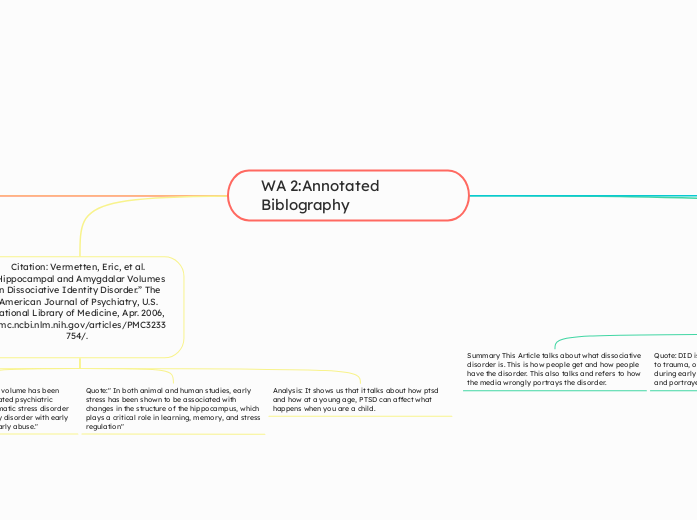WA 2:Annotated Biblography
Citation-Bauder, David. “The British Royal Family Learns That If You Don’t Fill an Information Vacuum, Someone Else Will.” AP News, AP News, 27 Mar. 2024, apnews.com/article/princess-kate-cancer-media-online-internet-49d725512152e60d8fbe7bd093b8d5c6.
Summary: This article talks about what Dissociative disorder is. It also talks about how common and uncommon it is. It tells us details about the mental disease and what each part of it means. For example what dissociative means and how it applies to this disorder.
Quote: "Dissociative identity disorder (DID), formerly known as multiple personality disorder and split personality disorder, is a mental health condition where you have two or more separate identities."
Quote: "“Dissociate” means to separate or disconnect. People with dissociative identity disorder may experience several different personalities, usually referred to as alters. Each identity may have different behaviors, memories, thought patterns or expressions. The identities might have different ethnicities and ways of interacting with their environments."
analysis: As this article talks about, it gives us the readers details on what the real meaning of Dissociative Identity Disorder really means. It gives us other meanings for it and it also gives us details on how it affects other people. It also tells us different types of the disorder.
Ciation-Mitra, Paroma. “Dissociative Identity Disorder.” StatPearls [Internet]., U.S. National Library of Medicine, 16 May 2023, www.ncbi.nlm.nih.gov/books/NBK568768/.
Summary: In this article it talks about how it is caused when people have Dissociative Identity Disorder. It talks about how trauma is one of the main reason for the disorder to happen to young children in there childhood.
Quote: "Dissociative identity disorder is typically associated with severe childhood trauma and abuse. Dalenberg and his team have detailed the role of trauma in the development of dissociative disorder and dismissed the previous model, which was based on fantasy and often associated with suggestibility, cognitive distortions, and fantasy."
Quote: Dissociative disorders show a prevalence of 1% to 5% in the international population. Severe dissociative identity disorder is present in 1% to 1.5% of this population.
Analysis: it shows us that the disorder isn't common, but it has been shown in early kids development and is cause by trauma. the way to cure it is to try to fight the trauma with therapy.
Citation: Vermetten, Eric, et al. “Hippocampal and Amygdalar Volumes in Dissociative Identity Disorder.” The American Journal of Psychiatry, U.S. National Library of Medicine, Apr. 2006, pmc.ncbi.nlm.nih.gov/articles/PMC3233754/.
summary: This is an article that talks about what is going on in your brain. It talks about what parts of your brain that is making the disorder happen.
Quote: Smaller "hippocampal volume has been reported in several stress-related psychiatric disorders, including posttraumatic stress disorder (PTSD), borderline personality disorder with early abuse, and depression with early abuse."
Quote:" In both animal and human studies, early stress has been shown to be associated with changes in the structure of the hippocampus, which plays a critical role in learning, memory, and stress regulation"
Analysis: It shows us that it talks about how ptsd and how at a young age, PTSD can affect what happens when you are a child.
Citation Dissociative Identity Disorder: What You Need to Know | Mclean Hospital, www.mcleanhospital.org/essential/did. Accessed 21 Feb. 2025.
Summary This Article talks about what dissociative disorder is. This is how people get and how people have the disorder. This also talks and refers to how the media wrongly portrays the disorder.
Quote: DID is associated with long-term exposure to trauma, often chronic traumatic experiences during early childhood. It is often misunderstood and portrayed incorrectly in popular media
Quote: Dissociative identity disorder—a type of dissociative disorder—most often develops during early childhood in kids who are experiencing long-term trauma.
Analysis: This talks about the Trauma and how it is developed. it teaches us how it works. It also teaches us the trauma on how
Citation: “Dissociative Disorders.” Mayo Clinic, Mayo Foundation for Medical Education and Research, 31 Aug. 2023, www.mayoclinic.org/diseases-conditions/dissociative-disorders/symptoms-causes/syc-20355215.
Summary: this talked about what symptoms come with it and it talks about what the disorder is and what it does to people. It also talks about young age where it is common from trauma.
Quote:
Symptoms depend on the type of dissociative disorder, but may include:
A sense of being separated from yourself and your emotions.
Thinking that people and things around you are distorted and not real.
A blurred sense of your own identity.
Severe stress or problems in relationships, work or other important areas of life.
Not being able to cope well with emotional or work-related stress.
Memory loss, also called amnesia, of certain time periods, events, people and personal information.
Mental health problems, such as depression, anxiety, and suicidal thoughts and behaviors.
Quote:Formerly known as multiple personality disorder, this disorder involves "switching" to other identities. You may feel as if you have two or more people talking or living inside your head.
